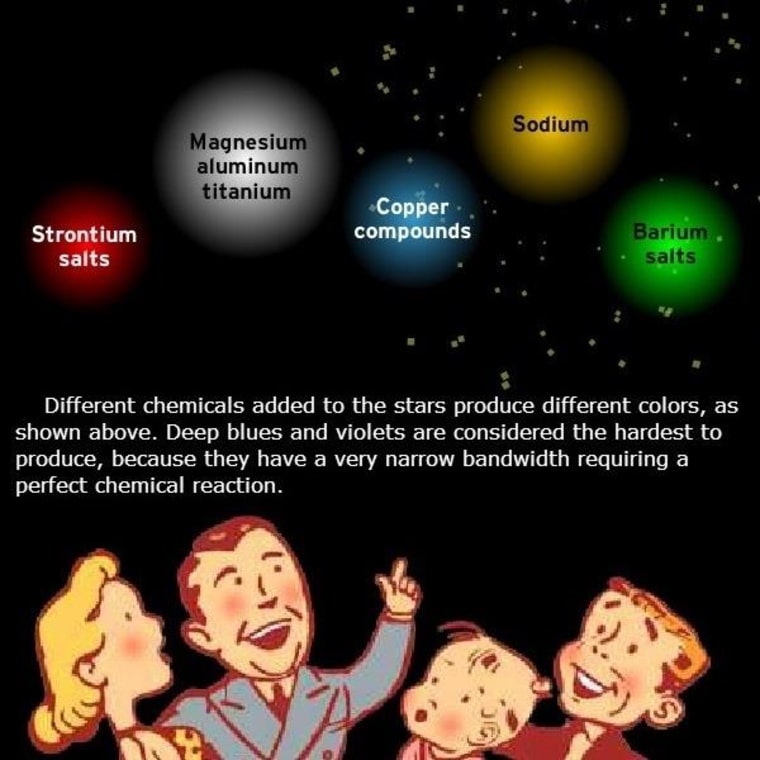When you look up at those Fourth of July fireworks, say hooray for the red and white — but give a special cheer for the blue.
"People have been trying to make a good blue for 500 years, and they haven't quite perfected it," John Conkling, a chemistry professor emeritus from Washington College in Maryland, told NBC News. "Purples we're getting good at. Pinks are decent. But blues are a big challenge."
Sign up for Science news delivered to your inbox
Conkling should know: He literally wrote the book on the chemistry of pyrotechnics, and is featured in a new video on the subject from the American Chemical Society. The way Conkling sees it, scientists still have a lot to learn about the science of fireworks, thousands of years after the Chinese invented them.
Even today, the Chinese are setting the pace in the global fireworks industry. "More and more of the product these days is made in China, so if there was a lot of research and development, it'd be going on in China," Conkling said.
But there's still something to be said for American know-how: Every year, specialty fireworks manufacturers in the United States come up with fresh twists — with a big assist from the U.S. Army.
"Pyrotechnics is one leg of a four-legged stool in the energetics field," said James Wejsa, chief of the pyrotechnics technology and prototyping division at the Army's Picatinny Arsenal in New Jersey. "We also have the propellants, the explosives and the warheads. The military is the one who really drives the technology in this area, and usually what you have are spin-offs in the commercial sector."
'Greener' fireworks from the Army
For example, Picatinny has been working on more environmentally friendly ingredients for the pyrotechnics that produce colored signals as a means of non-verbal communication on the battlefield.
"Getting new dyes and new ways to burn the formulations with different fuels is a challenge," Wejsa said. "The last thing you want is to have a soldier saying, 'Is that red smoke or violet smoke?' It could be the difference between 'shoot me' and 'don't shoot me,' you know what I'm saying?"
It turns out that the new formulations just might improve your neighborhood Fourth of July fireworks show as well. The Army has been working on a spin-off with Fireworks by Grucci, one of the biggest companies in the business.
"These formulations burn brighter and they burn clearer because there's less smoke," Wejsa said. "It's almost like going to high definition, because you don't have the smoke obscuring the color."
Wejsa and his team are making fireworks "greener" in more ways than one: They've developed a technique to produce a bright green flare using boron carbide rather than toxic barium compounds, a smoke grenade that emits less hazardous smoke, timing fuses and other pyrotechnics that don't leave potentially toxic perchlorate residues, and explosive primers that don't use lead.
"Our goal is to spin this off to commercial applications," Wejsa said.
The future of fireworks
So what's next? "The newest thing has been to try to perfect colors that normally people don't see in fireworks," Conkling said. Like a bright true blue, or really good orange.
"All the blues we see now have a copper compound that's at the heart of the reaction," Conkling explained. "The battle you're fighting here is that colored fireworks are brightest at high temperatures, but the copper emitter is not stable at high temperatures. So you have to play a game of 'The Price Is Right.'"
To produce an especially orange blast, chemists try blending run-of-the-mill sodium yellow-orange with red, but the job requires a lot of experimentation. The resulting recipes are closely held. "The old U.S. fireworks makers used to say there were some formulas they wouldn't even tell their grandmothers," Conkling said.

Another frontier for fireworks has to do with creating shapes in the sky. "It's common to see the heart pattern, the five-pointed star, multiple rings," Conkling said. "The logical extension of that would be letters, and being able to orient the letter up in the sky so you could spell out 'NBC' or something like that."
Fireworks by Grucci is already experimenting with a couple of technologies called PixelBurst and SkyEtching to create complicated patterns, letters and numbers. The technique was used for the countdown in Grucci's Dubai New Year's Eve display — and although the numbers are a bit hard to read, Conking is confident pyrotechnicians will work out the bugs. "It isn't like putting a man on the moon to do that," he said.
Will your fireworks be rained out? A guide for East Coasters
Besides the military, theme parks are the main drivers for innovation in fireworks displays — and sometimes it's not strictly about the fireworks. For example, the "Frozen" spectacular that's due to make its debut at Disney's Hollywood Studios in Florida this week will supplement the evening sky show with a video projection of social-media "selfies" submitted by parkgoers during the day.
When Conkling attends the Fourth of July festivities with his four grandchildren in Chestertown, Maryland, he'll be watching for the blues in the red-white-and-blue. But like most fans of the Fourth, he recognizes that a fireworks display isn't just a chemistry experiment. The winning formula also requires a healthy dose of flag-waving — and a flair for drama.
"One thing I like is a well-paced show," he told NBC News. "There should be no dead spots in it, and there should be some variety in it. It's not just the same thing over and over again."